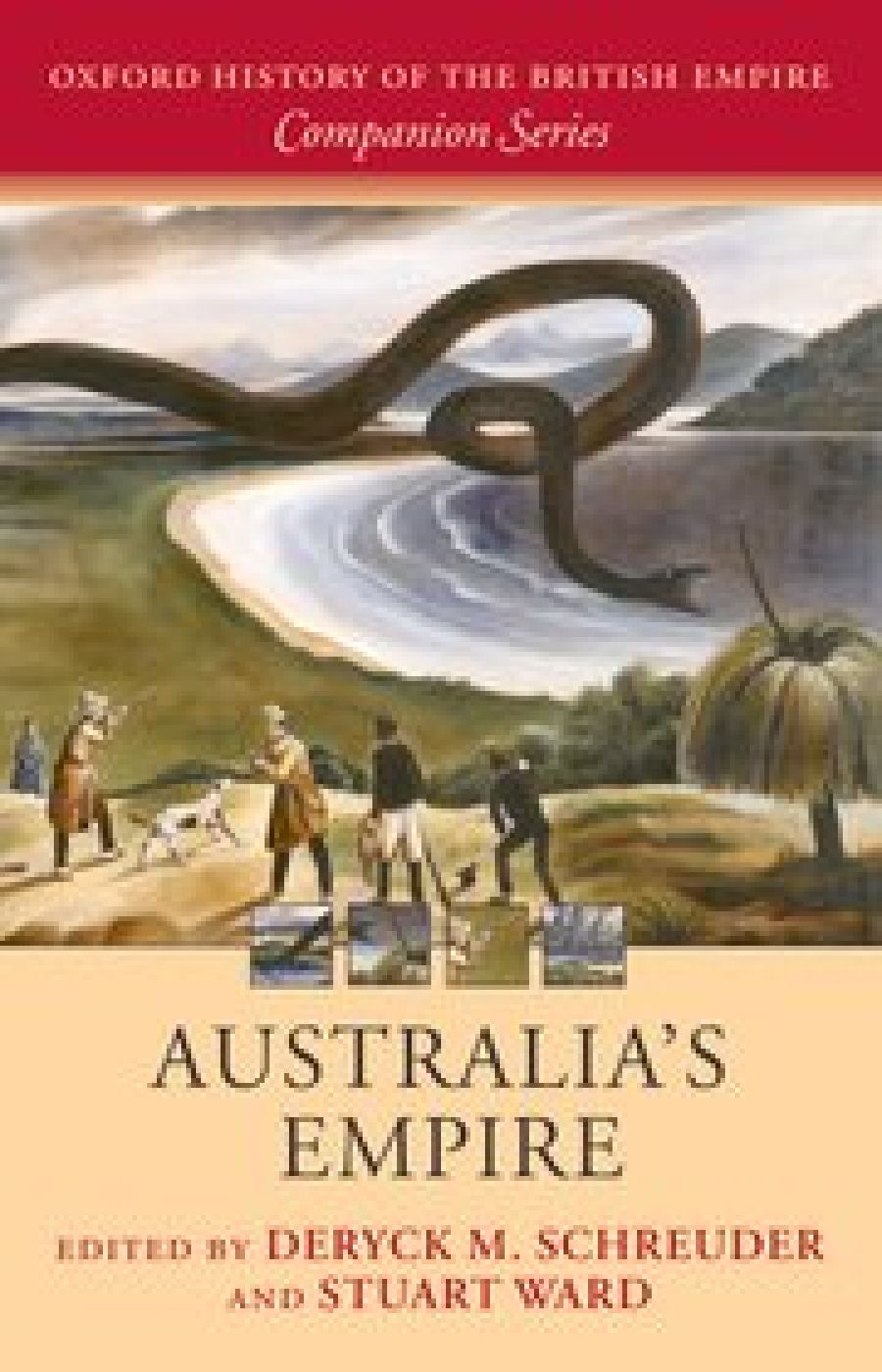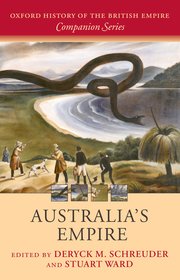
- Free Article: No
- Contents Category: Australian History
- Review Article: Yes
- Article Title: Whose empire was it?
- Online Only: No
- Custom Highlight Text:
One of the more successful ventures of Oxford University Press in the closing decades of the last century was a five-volume History of the British Empire. With more than a hundred contributors, this was a major undertaking, but its beginnings were not auspicious. Roger Louis, a professor at the University of Texas, Austin, was appointed editor-in-chief. That drew a public complaint from Max Beloff, an Oxford professor and founding principal of the private University of Buckingham, who was raised to the peerage by Margaret Thatcher. Beloff wanted to know why OUP was allowing an American to rewrite ‘our colonial history’.
- Book 1 Title: Australia’s Empire
- Book 1 Biblio: OUP, $99.95 hb, 419 pp
- Book 1 Cover Small (400 x 600):

- Book 1 Cover (800 x 1200):

Beloff was not deterred by his friendship with Louis, who was and is a distinguished historian of the British empire, with an affinity for his subject. Rather, the Englishman was affirming a proprietary claim that has a long history. When John Seeley wrote The Expansion of England in 1883, from the Cambridge chair of modern history, he established a persistent pattern whereby the empire was a British, if not an English, phenomenon, directed and controlled from Whitehall. The editors of the interwar Cambridge History of the British Empire commissioned local scholars to undertake accounts of the Dominions (so Melbourne’s Ernest Scott edited the Australian volume), but the enterprise was designed by British professors to show British energies acquiring, organising and coordinating their over-seas territories.
As the empire broke up, that way of understanding its history yielded to an appreciation of the forces at work in the colonies of settlement and conquest. Imperial historians such as Ronald Robinson and Jack Gallagher showed them both collaborating with and resisting the British presence, sometimes initiating territorial expansion and sometimes asserting their own interests through imperial means. Keith Hancock fostered similar work at the Institute of Commonwealth Studies in London, and more recently a travelling conference has taken up the idea of the British World as a way of exploring its multiple forms.
Such work requires a familiarity with national histories – for the dominant impulse of historical scholarship in the second half of the twentieth century was to tell the national story – and a readiness to challenge their solipsism. We still find British historians venturing explanations and surveys with an insouciant ignorance of such histories, most notably Andrew Roberts, whose egregious History of the English-Speaking Peoples since 1900 (2006) is apparently admired by Alexander Downer. But that was certainly not the case with the Oxford History. Its contributors were fully conversant with their subject.
According to Louis, Beloff’s ire was aroused partly by his exclusion and partly by some of the inclusions. Beloff had recently heard a paper from Susan Pedersen, a historian currently working at Columbia with a particular interest in women’s role in settler colonialism. ‘I will not have the history of the British Empire held hostage to the hysteria of American feminists,’ he thundered. Pedersen is in fact Canadian, but Beloff’s ire draws attention to another fault-line in the field.
Working alongside the imperial historians are the devotees of post-colonialism. Imperial historians concentrate on strategic, diplomatic and political policies, patterns of trade and investment, and the movement of people, institutions and practices. Post-colonialists are more interested in how the imperial project used various forms of knowledge to construct the colonial subject, working especially with differences of indigeneity, ethnicity and gender to destabilise the imperial understanding.
Yet even in this work a national division of labour persists. Scholars in the former colonies trace the troublesome legacy of the imperial presence. British scholars dwell on its pervasive effects on the homeland in studies that range from the memsahib and the missionary to post-1945 migration from the Caribbean and South Asia. All insist on their particular burden of empire; indeed, there are moments when the participants seem to be reworking the Monty Python sketch on childhood deprivation: my empire was worse than yours.
If Lord Beloff were alive to read it, I doubt that he would take exception to this volume on Australia’s Empire. One of a companion series to the five-volume Oxford history, it takes up aspects that could not be covered in the Australian chapters of that work. The editors, Deryck Schreuder and Stuart Ward, are both recognised authorities on the subject, and have both done work beyond Australia that enables them to appreciate its distinctive characteristics. The contributors include leading historians who develop their topics with assurance.
Prominent examples are the chapters on ‘conquest’ by Alan Atkinson, Aborigines by Ann Curthoys, migration by Eric Richards, the economy by Geoffrey Bolton, security by Stuart Ward, and monarchy by Mark McKenna. All provide succinct interpretative essays that explore the imperial effect.
Atkinson’s treatment of the British occupation of Australia draws on his detailed account of The Europeans in Australia: A History (1997, 2004) and displays a deft economy; it also takes him into the disputed territory of the ‘history wars’, on which he writes with a studied restraint. ‘It has been estimated,’ he states, ‘that rather more than 187 Tasmanian settlers were killed by Aborigines between 1824 and 1831. Black fatalities were very poorly documented, but the total was probably two or three times that number.’ A footnote directs the reader to the literature on the subject and notes that Keith Windschuttle has argued for a maximum of 101 Aboriginal victims: ‘but [Windschuttle’s] logic confuses maximum with minimum.’ As Atkinson puts it, the conquest of Australia was an extended process based on a myth of original vacancy and the ensuing ‘intermixture of violence and enlightenment is one of the most remarkable aspects of Australian history’.
Ann Curthoys takes up the contradictions of the indigenous subject. The belief of Captain Cook and Joseph Banks that the land was thinly inhabited allowed the British to treat it as vacant for possession and removed the need for negotiating the terms of their occupation. Since the original people were turned into British subjects, there could be no acknowledgment of war with them, and the Colonial Office became increasingly concerned by the colonial disregard of their rights. For their part, Aborigines – along with Maori, Native Americans and other indigenous peoples of the Empire – began to see the Crown as an alternative source of authority to redress their grievances, and continued to do so until well into the following century.
The growing recognition of this aspect of settler colonialism has been one of the reasons for the revival of interest in imperial history, but I think it probably lets London off too lightly. When the Australian colonies were invited to draft constitutions for self-government in the 1850s, Westminster allowed them to do so without any acknowledgment of the Aboriginal presence; the effect was to terminate the meagre protections previously provided by the Crown. In striking contrast to the Canadian arrangement, which afforded recognition, Aborigines were expressly excluded from the ambit of the Commonwealth government created in 1901; and while Britain sought and secured imperial safeguards in that constitution, it allowed the discriminatory provisions to stand.
This is one of the reasons for thinking that John Hirst is too sanguine in his chapter on the imperial contribution to the Australian system of government. In a typically iconoclastic manner, he takes aim at the usual nationalist interpretation. ‘The foundations of an open, liberal society,’ he insists, had been laid under British rule, ‘which explains why the so-called liberals who took power after self-government had so little to do’. The result was dependence on an omnicompetent state that made little call on citizenship, and required no breach with Westminster for nationhood.
The imperial legacy is fully apparent in these chapters, but some of the other contributors struggle to find it in theirs. Richard Waterhouse summarises the patterns of land use that he explored in his recent history of rural Australia, and the influence of empire is exiguous, though he does note how the late nineteenth-century birthplace of the bush legend seedbed was transformed by the end of the following century into a bastion of Anglo-Celtic conservatism. Anne Gray’s chapter on art is not so much an account of the imperial as of the European vision of the Australian landscape, and is wobbly in its treatment of context. She writes that half the national income in the 1920s derived from pastoral and agricultural production; the actual proportion was a little over twenty per cent at the beginning of the decade, and seventeen per cent at its close. Hilary Carey’s chapter on religion has another statistical glitch: the 17,287 Jews enumerated in the 1911 census made up less than 0.5 per cent of the population, not five per cent.
Richard White and Hsu-Ming Teo undertook one of the more challenging assignments, a survey of popular culture, and handle literature, sport, advertising and radio with insight. A similar chapter on science, education and expertise would be useful. To my mind, one of the most stimulating chapters is the one on the changing forms of Britishness in Australia by Neville Meaney, taking up ideas he has explored in previous publications and illuminating shifts in national identity. Together with the editorial introduction and epilogue, these make a persuasive case for bringing the imperial dimension back into Australian historiography.
But it will take more than that to persuade the British that we too have an imperial history. Richard White and Hsu-Ming Teo conclude their chapter with the visit of John Howard and a large delegation of dignitaries to London in July 2000 to mark the centenary of the passage of the Commonwealth of Australia through the Imperial Parliament. This was indeed an exercise in popular culture, with the sounds of the didgeridoo and the banal lyrics of ‘I am Australian’ filling Westminster Abbey, but it was only noticed by the British press as ‘some arcane Commonwealth anniversary’. Lest we forget – lest we forget!


Comments powered by CComment